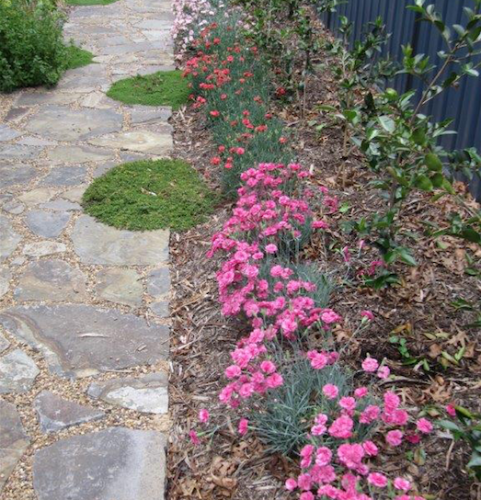

Plus there’s the multiplying factor of getting extra plants by dividing and collecting seed.
This week I have suggestions for spring-flowering perennials, many of which will flower into summer. Then, in a few weeks’ time, suggestions for summer-to-autumn flowering perennials, thus providing a continuous display from now until March.
The plants listed are available from local garden centres:
- Ajuga “Black Scallop” is a superb ground cover of 10cm high x 80cm wide with purple, marbled leaves and blue flower spikes in spring. Dividing a clump yielded more than 20 extra plants.
- There are numerous armeria, starting with “Pink Petite”, “Bees Pink” and “Bees Ruby”, all of which grow to 15cm high x 30cm wide. It’s an ideal border plant along paths spaced 15cm apart.
- Then there are the old-fashioned pinks or dianthus, mentioned in Shakespeare’s “A Winter’s Tale”. My favourite is Dianthus “Sugar Plum”, which grows to 30cm wide x 40cm high.
- A ground cover equally at home spilling over a stone wall or a hanging garden is Convolvulus “Blue Moon” with rich-blue flowers or “Silver Moon”, with pure-white flowers, just two of many varieties.
- Erigeron “Spindrift” has pink and white daisy-like flowers over a long period, just 20cm high x 50cm wide.
- There are many gaura and I particularly recommend “Crimson Butterflies”, with deep, rose-coloured flowers, 45cm high x 60cm wide.
- French lavenders are the earliest to flower starting with the new Lavendula “Winter Lace”, followed by “Blueberry Ruffles” and “Strawberry Ruffles”, all 60cm high x 80cm wide. Keep in mind the spread of all these plants so they don’t smother each other. The most effective planting is always in groups of three, five or seven.

Originating from the Mediterranean, the Romans found it could be preserved in honey and vinegar, which added to the taste. It’s said Catherine de Medici took them to France when she married Henry II in the 16th century.
Globe artichokes are the unopened buds of the thistle family. When left to mature, the bud opens to a rich-purple, thistle-like flower. They are often grown in ornamental gardens, keeping in mind they take up considerable space and grow up to a metre.
They can be grown from suckers from an existing plant or from seed, a popular variety being Yates’ “Green Globe”.
Classed as perennials, they can be cut back to ground level in late autumn. It’s suggested that buds are picked while firm and before they open. Cook by boiling or steaming for 45-60 minutes.
Jottings…
- A light prune of daphne after flowering is recommended. Yellowing leaves (as opposed to old leaves shedding at the base of each stem) suggests a magnesium deficiency, so apply a heaped teaspoon of Epsom salts to a watering can.
- It’s still too early to plant potatoes, but prepare the ground by mixing cow manure with blood and bone into the soil.
- All bush roses can be pruned now. Rambling and weepers are pruned after flowering. Remove some of the older wood to encourage new, strong shoots from the base. Reduce the whole bush by at least a third.
- Plant ericas for late-winter flowering, hardy in sun or light shade and great for bees.
- Cut back foliage on ornamental grasses such as miscanthus.
- Chris Braddick will speak on “The History, Structure and Elements of the Japanese Garden” at the next Horticultural Society meeting at the Wesley Church Centre, National Circuit, Forrest, from 7.30pm on Monday, August 15. All welcome with supper after the talk.
Who can be trusted?
In a world of spin and confusion, there’s never been a more important time to support independent journalism in Canberra.
If you trust our work online and want to enforce the power of independent voices, I invite you to make a small contribution.
Every dollar of support is invested back into our journalism to help keep citynews.com.au strong and free.
Thank you,
Ian Meikle, editor




Leave a Reply